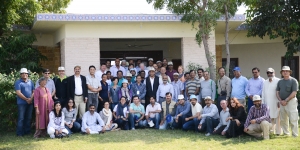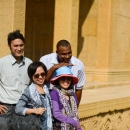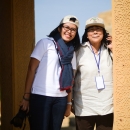Newsroom :: News :: 2012 :: A field trip to Makli necropolis, Keenjhar Lake and the Shahjehan Mosque at the end of RSC 9
A field trip to Makli necropolis, Keenjhar Lake and the Shahjehan Mosque at the end of RSC 9
Location: Karachi, Pakistan. 21st Nov 2012
Day four brought forward a unique learning and recreational opportunity for over 50 participants at the RSC 9. A fieldtrip was planned for the participants where they enjoyed the ancient carvings at the Makli necropolis, had lunch at the Keenjhar lake and spent some quiet, reflective moments at a 16th century Mughal era monument - the Shahjehan Mosque. After three days of riveting discussions in the environs of a local hotel, the participants seemed happy to explore the unique heritage and ecology of the country.
An early afternoon autumn breeze greeted the visitors when they arrived at the Makli Hills- one of the largest necropolises in the world. It has been on the tentative UNESCO World Heritage Site List since 1993. Makli necropolis is the burial place of some 125,000 local rulers and Sufi saints and some of its ancient tombs have designs and carvings dating back thousands of years.
After a brief stop over at a 12-acre patch of freshwater Avicennia marina, the visitors then proceeded to the picturesque Keenjhar Lake, the second largest fresh water lake and a Ramsar site in Pakistan. It is a wildlife sanctuary and winter ground for migratory birds like Ducks, Geese, Flamingos, Cormorants, Herons, Egrets, Ibises, Coots and Gulls and the breeding area of Night Heron, Cotton Tealand Pheasant Tailed Jacana.
Following a quick boat ride around the lake, the Sindh Livestock and Fisheries Department hosted a scrumptious lunch prepared in traditional spices. Local musicians held the audience captive with their musical rendition of Shah Abdul Latif Bhittai’s poetry. Director General Fisheries, Mr. Ghulam Mohammad Meher highlighted the rich cultural heritage of Sindh and appreciated the visitors’ keen interest in local crafts and music. Ms. Maeve Nightingale, Head of the Coastal and Marine Programme IUCN Asia and Ms. Janalezza Morvenna A. Esteban, MFF Regional Knowledge Management Officer acknowledged the local hosts for their warm hospitality.
The delegation stopped briefly at the Chillya fish hatchery of the Sindh Livestock and Fisheries department and then moved towards the architectural jewel of Sindh, the Shahjehan Mosque, built in 1647 during the reign of Mughal King Shahjehan. It is said that Shahjehan built the mosque as a gesture of gratitude to the people of Thatta for sheltering him during his youth when his father had banished him from Delhi. The mosque was built keeping acoustics in mind- a person speaking inside one end of the dome can be heard at the other end when the sound exceeds 100 decibels. The visitors admired the red bricks, the blue glazed Hala tiles and the beautiful interplay of light inside the mosque.
As the sun started setting behind the majestic domes of the Shahjehan Mosque, the visitors bid adieu, slowly and reluctantly, to the ancient town of Thatta.


